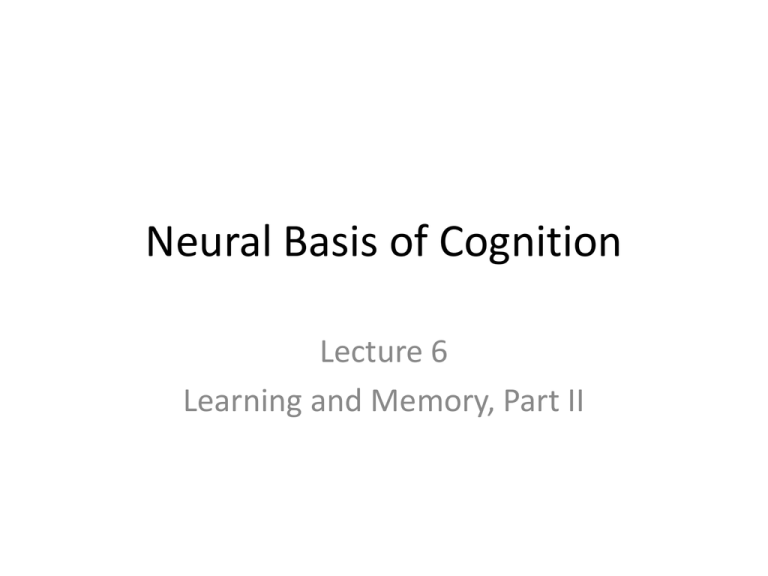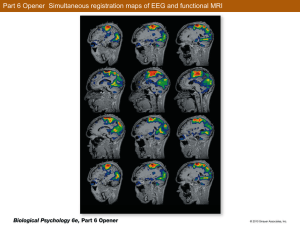Slides
advertisement

Neural Basis of Cognition Lecture 6 Learning and Memory, Part II Memory • Extensive hippocampal damage leads to amnesia • The hippocampus receives highly preprocessed input from multiple areas and projects back to them • The hippocampus is activated during memory encoding, consolidation, and retrieval • Pre-existing memories are left intact by hippocampal damage • Memories are thought to be stored in the areas that initially processed given information Memory • What about working memory? • Are any other areas of the brain related to memory? • What is the relationship between memory and emotion? • Given the relatively stable “neural wiring” in the brain, how is memory possible? Memory What about working memory? Working Memory • Fulton, 1935: Frontal cortex lesions and their effect on the spatial delayed-response task with dogs – Food is put in one of several wells and each well is closed; after some delay, the animal is given the opportunity to choose a well – Frontal cortex lesions destroyed the ability to remember which well contained food Working memory • Dorsolateral prefrontal cortex (DLPFC) Working Memory • Golman-Rakic: DLPFC lesions and their effect on an occulomotor version of the delayed-response task with monkey – While the monkey looks at a fixation point, one of eight target locations is briefly lit; after the light goes off, after some delay the monkey must saccade to the target – DLPFC lesions severely impair performance on this task – Neurons in the DLPFC continue firing during the delay period – This neural activity is absent on trials in which the monkey makes a mistake Working Memory • Single cell recording studies show that the exact region of the DLPFC that holds information online varies depending on the nature of that information – DLPFC: locations – Lateral PFC: objects Working Memory • Loss of working memory does not cause amnesia • Patient KF: – Could not hold online short strings or digits – Could learn word lists or stories Memory Are any other areas of the brain related to memory? Prefrontal Cortex (PFC) • Ventrolateral PFC activates during encoding of long-term memories – Lateralized – Activates regardless of conscious intent to encode memories (intentional vs. incidental encoding) – Exhibits subsequent memory effect Prefrontal Cortex (PFC) • Other regions of the PFC activate during memory retrieval • Patients with PFC damage tend to confabulate (generate narratives that include false memories) and an increased number of false positives in recognition-memory tasks – This implies that the PFC is involved in organizing and monitoring memory retrieval • PFC activation during memory retrieval is lateralized Prefrontal Cortex (PFC) • There is activity in posterior PFC during memory retrieval but this activity appears to be related to retrieval attempt rather than success • Greater activation for more poorly encoded memories • Amount of activation is independent of whether the item is successfully remembered Prefrontal Cortex (PFC) • Anterior frontopolar PFC region activates during retrieval and tends to be right lateralized regardless of the type of information • Degree of activation does not vary with difficulty of information retrieval • Activation is more common in free recall or cued recall tests Prefrontal Cortex (PFC) • In conclusion: – The PFC seems to be involved in strategic and executive aspects of memory. – The PFC appears to aide in organization, selection, monitoring, and evaluation of processing that occurs at both encoding and retrieval rather than in storage/retrieval of the actual contents of memory of experience Memory Are any other areas of the brain related to memory? Left Parietal Cortex • General role in memory retrieval, regardless of nature of content or of modality • More activation during retrieval of “old” information than of “new” information • Correct recall is associated with parietal cortex activity independent of the nature of the remembered material, suggesting that this activity reflects retrieval success Memory Are any other areas of the brain related to memory? What is the relationship between memory and emotion? Amygdala • Lesion of the amygdala but not of the hippocampus precludes fear conditioning but not the memory of the conditioning • Lesion of the hippocampus but not of the amygdala precludes the memory of conditioning but not the fear conditioning itself • Lesion of the hippocampus and of the amygdala precludes both Amygdala • Normally, emotional content of an experience results in enhanced recall • Lesion of the amygdala but not of the hippocampus destroys this enhancement but not the appreciation of emotion during the emotional experience itself • Interference of the function of the amygdala via beta-adrenergic antagonists temporarily caused the same effects as amygdalic lesion Memory Given the relatively stable “neural wiring” in the brain, how is memory possible? Long-tem potentiation (LTP) • 1894: Ramon y Cajal suggests the strengthening of connections between existing neurons as a possible mechanism for memory formation • 1949: Hebb: “When an axon of cell A is near enough to excite a cell B and repeatedly or persistently takes part in firing it, some growth process or metabolic change takes place in one or both cells such that A's efficiency, as one of the cells firing B, is increased.” • 1966: Lomo discovers that tetanic stimulus of a neuron causes it to subsequently cause larger EPSPs, what is now called long-term potentiation (LTP) LTP/LTD LTP/LTD • If neuron A fires before neuron B fires: LTP • If neuron A fires after neuron B fires: LTD LTP/LTD • Blocking NMDARs prevents LTP LTP/LTD • Asymmetric learning rule • What could be the mechanism behind the induction of LTP/LTD? LTP/LTD Ca2+/calmodulin-dependent protein kinase II (CaMKII) is localized in the postsynaptic density (PSD) and is necessary for LTP induction LTP/LTD LTP/LTD LTP/LTD • Strong Ca2+ influx leads to phosophorylation of CaMKII, which leads to an increase in the number of AMPA receptors in the cell membrane, inducing LTP LTP/LTD LTP/LTD • “a phosphatase (PP2A) switch,… together with a kinase switch [forms] a tristable system. PP2A can be activated by a Ca2+-dependent process, but can also be phosphorylated and inactivated by CaMKII. When dephosphorylated, PP2A can dephosphorylate itself.” • “the kinase activity is high in the LTP state; the PP2A activity is high in the LTD state and neither activity is high in the basal state.”











